WWII AAF Towel U. S. ARMY AIR FORCES (original'CANNON' label) 40 x 22 MINT
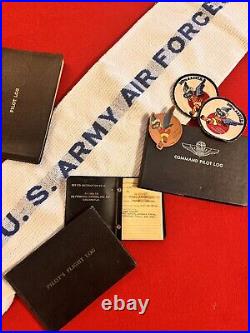
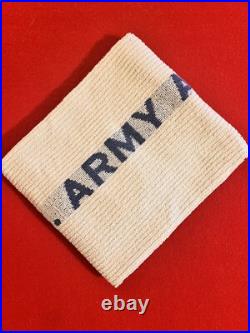

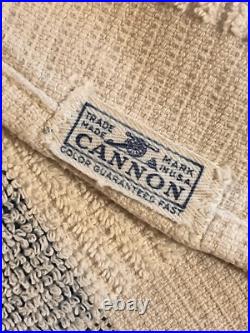
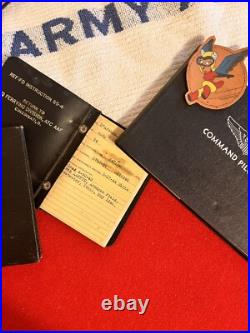
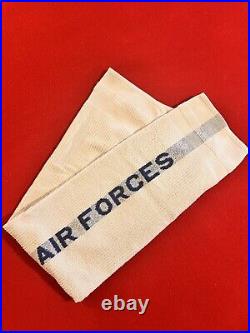

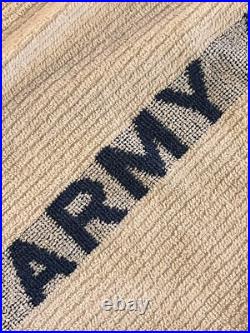
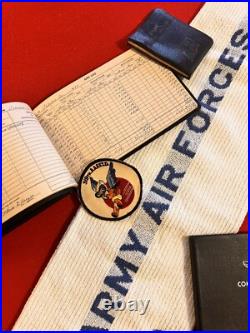
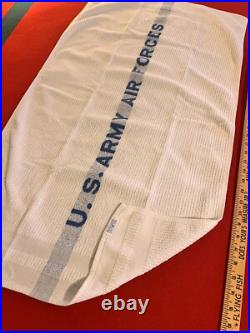
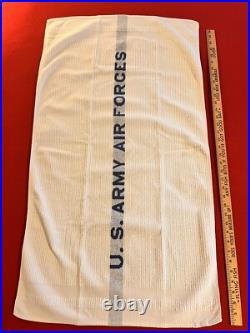
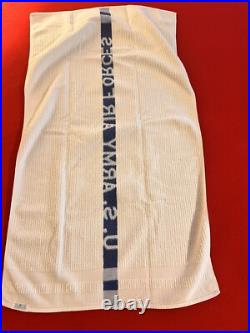
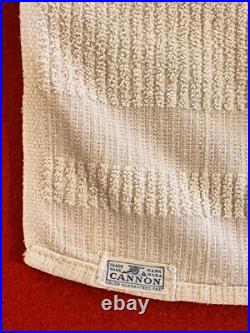
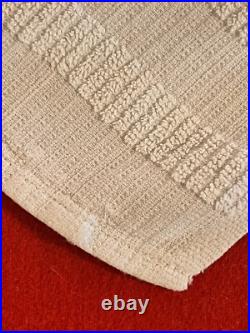
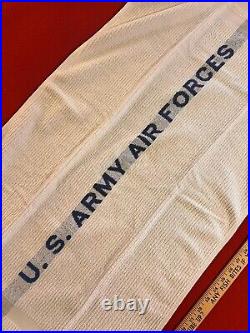
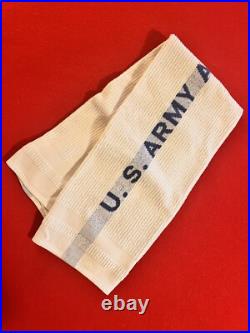
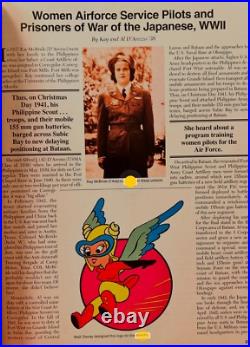
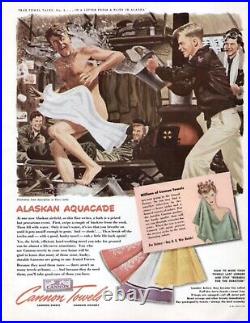
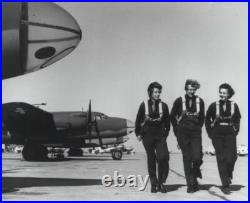

ARMY AIR FORCES" (with the original'CANNON MILLS' label) 40" x 22. NOTE: This is an ORIGINAL contract item of the "ARMY " combat arm, NOT the separate U. ARMY AIR FORCES existed by this name fr om June 20, 1941 until June 26, 1947. By 1945 2,253,000 men and women were serving in the ARMY AIR FORCES! This towel belonged to my mother who served as one of Hap Arnold's, Nancy Harkness Love's, and Jacqueline Cochran's 1,074 pioneering WOMEN'S AIRFORCE SERVICE PILOTS (WASP).
She trained at AVENGER FIELD, Sweetwater, Texas, and flew out of LOVE FIELD, Dallas, ferrying all manner of aircraft until the dissolution of the unified command on December 20, 1944. Were woven with the name of the organization in a central strip. + ZERO holes, snags, stains, fraying, loose stitching or personalized markings, e.
+ Very few of these survive today! Any item of such obvious utility was "used up" after the war to wash the car, or as a household rag! + One of these towels was carried in a pilot or a bomber crewman's M1936'Musette' Bag or by a Tenth AAF'Hump' pilot in the CBI...Or stowed in a crewman's footlocker on an Eighth AAF airfield in East Anglia.. Or by personnel at one of the forward Fifth, Seventh, or Thirteenth AAF airfields in the Southwest Pacific Theater. The wartime owner of this towel could have been a P-51 Mustang pilot, or a B-17 pilot, gunner, navigator, or a ground crew chief! + Dimensions: 40" x 22". + Unlike less expensive towels, this thick chenille towel is woven with multiple "thirsty" looped rows!
+ Down the center, woven in deep "Air Force blue, " in bold san serif font, in lettering 1-1/4 tall. + Still attached is the original CANNON MILLS factory label (1-1/4" x 1/2"). Printed in blue ink on the white herringbone twill cotton tape is the iconic logos -- a Napoleonic smooth-bore cannon' with a stack of 6-lb. The Cannon Mills Company was an American textile manufacturing company based in Kannapolis, North Carolina, that mainly produced towels and bed sheets.
In 1928, Charles Cannon organized nine textile companies into a large corporation, Cannon Mills. 300,000 towels were produced each day, and it soon became the world's largest producer of textile products. STATE UNIVERSITY: TEXTILES HISTORY site. Cannon 1852-1921 and Charles A. Cannon 1892-1971 were a father and son team who wrote the history of towel production in North Carolina. Was born in Mecklenburg County North Carolina to a family of farmers and planters. He was educated in private school but withdrew in1866 at age 14 to begin work in a store in Charlotte. In 1868, he joined Cannon, Fetzer and Wadsworth, a mercantile company in Concord just a few miles north of Charlotte, where his brother was a partner. He was elected a director of the Odell Manufacturing Co.In 1887, he became interested in textile manufacturing and left his brother's firm to build a mill for spinning coarse cotton yarn, Concord Manufacturing Co. This led to the formation of other mills: Cabarrus Cotton Mills founded at Concord, N. Cannon and others; Patterson Manufacturing Co.
Founded at China Grove, Rowan Co. Cannon, and others; Kesler Manufacturing Co. The expansion was due in part to the manufacture of something a little different. That product was termed "Cannon Cloth", a coarse cloth suitable for wiping.
Meanwhile, in 1892, a son, Charles Albert Cannon, was born. In the mid1890s, James W. Cannon decided to manufacture cotton towels. In 1898, his mill produced the first towel finished in the South.Other mills followed over the next ten years. 1898 Wiscassett Mills Company founded at Albemarle, Stanly County, N. 1899 Windemere Knitting Mills established at Albemarle, Stanly County, N. By the Cannons and others. Founded in 1903 at Statesville, N.
1903 Windemere Knitting Mills became part of Wiscassett Mills Co. 1906 Franklin Cotton Mills established at Concord, N.By members of the Cannon family. 1907 Barringer Manufacturing Company founded. About 1906, Cannon decided to build a mill and a town devoted exclusively to the manufacture of towels. He named it Kannapolis after the Greek root, namely, city or place of Cannon. Kannapolis developed into the largest unincorporated town in the world.
Cannon built houses, schools, churches - everything needed for a town. When the mill opened in 1908, it could produce more towels than any group of mills. In addition to being a towel city, Cannon had done enough for his employees that Kannapolis was recognized as a model city. The Cannon Mill manufactured a variety of cotton cloth into muslin and percale sheets and pillowcases, tire fabrics, and women's hosiery. Additional mills were opened and acquired.
1909 Imperial Cotton Mills founded at Eatonton, Georgia, by J. 1911 Buck Creek Cotton Mills f ounded at Siluria, Ala. 1913 York Cotton Mills, York, S.
With the Cannons and the Southern Power Co. 1915 Social Circle Cotton Mill Co.
Walton County, Georgia, acquired by the Cannons. Son Charles Albert Cannon became company president. In Kannapolis, more than 300,000 towels were produced each day.
Charles did not stop and rest on his father's laurels. Further expansion was required to keep up with the growing prosperity of the Roaring Twenties. Consolidation was needed in order to bring order to the farflung empire. In 1928, Cannon Mills was formed from consolidation of Cannon Manufacturing Co. Cabarrus Cotton Mills, Barringer Manufacturing Co. Franklin Cotton Mills, Gibson Manufacturing Co. Norcott Mills, and Hobarton Manufacturing Co.In approximately 1928, Bloomfield Manufacturing Co. Was acquired by Cannon Mills.
Swink Manufacturing Company was dissolved in 1931 and assets taken over by Cannon and Swink. 1935 Issaqueena Mill, Central, S. 1944 - 1945 Plant at York, S. 1947 Brown Roberta Foundation established at Concord, N. 1949 Travora Textiles at Graham and Haw River, N. 1967 Travora Textiles at Graham and Haw River, N. 1970 - 1971 Brown Manufacturing Co.The end of the golden era of Cannon control came in 1971 when Charles Albert Cannon died. AIR FORCE HISTORICAL RESEARCH AGENCY.
+ From the close of the Civil War until 1907, the U. ARMY SIGNAL CORPS had acquired only eight balloons, though two more were procured in 1907. + The small AERONAUTICAL DIVISION of the U.Army Signal Corps was established in 1907. During the interwar period it was known as the AIR SERVICE. + The Air Corps Act of 1926 created the U. Marshall, USA Chief of Staff, established the ARMY AIR FORCES (AAF) on June 20, 1941, to control both the Air Corps and the Air Force Combat Command (formerly GHQAF). + The National Security Act of 1947 became law on July 26, 1947.
It created the DEPARTMENT OF THE AIR FORCE, headed by a Secretary of the Air Force. The Birth of the United States Air Force.This brief history surveys the beginning of the United States Army's air arm and the birth of the Air Service i n World War I. It traces the evolution of the Army's air combat branch between World War I and World War II and its tremendous organizational growth during World War II.
Following the war came various changes to cope with the establishment of a separate armed service independent of the United States Army (USA). On August 1, 1907, the US Army Signal Corps established a small Aeronautical Division to take charge of all matters pertaining to military ballooning, air machines, and all kindred subjects. " There were at the time few aeronautical "subjects upon which to build. From the close of the Civil War until 1907, the Signal Corps had acquired only eight balloons, though two more were procured in 1907. But not until May 26, 1909, did Lts Frank P. Foulois make their first ascent and qualify as the airship's first Army pilots. The Air Corps Act of 1926 changed the name of the Air Service to Air Corps, but left unaltered its status as a combatant arm of the U. The act also established the Office of Assistant Secretary of War for Air. The Air Corps had at this time 919 officers and 8,725 enlisted men, and its "modern aeronautical equipment" consisted of 60 pursuit planes and 169 observation planes; total serviceable aircraft of all types numbered less than 1,000. In August 1926 the Army established the Air Corps Training Center in San Antonio, Texas.A few weeks later, on October 15, the logistical organization was placed on firmer footing with the establishment of the Materiel Division, Air Corps, at Dayton, Ohio. A year later this division moved to nearby Wright Field, thereafter the primary base for air logistics. In Texas, Randolph Field, the "West Point of the Air, " was dedicated on June 20, 1930, and became the headquarters of the Air Corps Training Center and the site of the primary flying school in 1931. By June 30, 1932, the Air Corps had grown to 1,305 officers and 13,400 enlisted men, including cadets, and possessed 1,709 aircraft distributed among four attack, 12 bombardment, 16 pursuit, and 13 observation squadrons. The Corps also possessed at this time two airship and two balloon squadrons.
On March 1, 1935, the General Headquarters Air Force (GHQAF), which had existed in gestation since October 1, 1933, became operational and assumed command and control over Air Corps tactical units. Tactical units, less some observation squadrons scattered throughout the nine USA corps areas, transferred to this initial air force. The three GHQAF wings were located at Langley Field, Virginia; Barksdale Field, Louisiana; and March Field, California. The Office of the Chief of the Air Corps (OCAC) and GHQAF existed on the same command echelon, each reporting separately to the Army Chief of Staff. The GHQAF Commander directed tactical training and operations, while the Chief of the Air Corps maintained control over procurement, supply, training schools, and doctrine development. On March 1, 1939, the Chief of the Air Corps assumed control over the GHQAF, centralizing command of the entire air arm. During the crisis over the partition of Czechoslovakia in the summer and autumn of 1938, the German Luftwaffe in a show of force demonstrated that airpower had become a powerful instrument in international relations. In September 1938, 500 Luftwaffe aircraft had supported German ground forces that occupied the Sudetenland, Czechoslovakia. Roosevelt acknowledged the growing importance of airpower, recognized that the United States might be drawn into a European war, and believed firmly, according to his adviser, Harry Hopkins, that airpower would win it. Assured of a favorable reception in the White House, the Air Corps prepared plans in October 1938 for a force of some 7,000 aircraft.Soon afterwards, President Roosevelt asked the War Departmen t to prepare a program for an Air Corps composed of 10,000 airplanes, of which 7,500 would be combat aircraft. In a special message to Congress on January 12, 1939, the President formally requested this program. Beginning in September 1939, the German Army and the German Air Force rapidly conquered Poland, Norway, Holland, Belgium, France, and within one year had driven the British off the continent.
Leaders of the Air Corps now found themselves in the novel position of receiving practically anything they requested. Plans soon called for 54 combat groups. This program was hardly underway before revised plans called for 84 combat groups equipped with 7,800 aircraft and manned by 400,000 troops by June 30, 1942. Army air forces strength in World War II would swell from 26,500 men and 2,200 aircraft in 1939 to 2,253,000 men and women and 63,715 aircraft in 1945. With this enormous expansion underway, the War Department began in 1939 to establish new bases and air organizations in rapid succession overseas and in the continental United States. At the same time air leaders worked to create an independent institutional structure for air within the U. Both necessity and desire thus caused a blitz of organizational changes from 1940 through 1942. On November 19, 1940, the General Headquarters Air Force was removed from the jurisdiction of the Chief of the Air Corps and given separate status under the commander of the Army Field Forces. Marshall, USA Chief of Staff, established the Army Air Forces (AAF) on June 20, 1941, to control both the Air Corps and the Air Force Combat Command (formerly GHQAF). The Air Corps, during this period of expansion and reorganization, created a new echelon that would in a short time become the numbered air forces. In December 1940, the War Department, to help control the growing tactical organizations, formed the Northeast, Northwest, Southeast, and Southwest Air Districts. These districts were redesignated in April 1941 as the 1st, 2d, 3d, and 4th Air Forces ; later, in September 1942, the Arabic designations were changed to the First, Second, Third, and Fourth Air Forces.The Hawaiian Air Force was activated on 1 November1940, the Panama Canal Air Force on 20 November 1940, and the Alaskan Air Force on 15 January 1942. These air forces subsequently became the Seventh, Sixth, and Eleventh Air Force s.
Early in 1941, the War Department instituted a series of actions to create a hierarchy for noncombat activities. It set up a command eventually designated Flying Training Command to direct new programs for training ground crews and technicians. The next year, the new command assumed responsibility for pilot and aircrew training. As the functions of the Ferrying Command expanded, it was redesignated as the Air Transport Command.To control supply and maintenance, the War Department established the Air Corps Maintenance Command under the Air Corps Materiel Division. The Materiel Division then concentrated on procurement and research development. A War Department reorganization on March 9, 1942, created three autonomous U. Army Commands: Army Ground Forces, Services of Supply (later, in 1943, Army Service Forces), and Army Air Forces.
This reorganization dissolved the Office of the Chief of the Air Corps and the Air Force Combat Command, and merged all elements of the air arm into the Army Air Forces. This administrative reorganization did not affect the status of the Air Corps as a combatant arm of the US Army. All of these actions affecting the air forces and commands that comprised the AAF emphasized the surge towards an independent service and the expansion of combat forces that took place during World War II. Before 1939 the Army's air arm was a fledgling organization; by the end of the war the Army Air Forces had become a major military organization comprised of many air forces, commands, divisions, wings, groups, and squadrons, plus an assortment of other organizations.Rapid demobilization of forces immediately after World War II, although sharply reducing the size of the Army Air Forces, left untouched the nucleus of the postwar United States Air Force (USAF). A War Department letter of March 21, 1946, created two new commands and redesignated an existing one: Continental Air Forces was redesignated Strategic Air Command, and the resources of what had been Continental Air Forces were divided among Strategic Air Command and the two newcomers - Air Defense Command and Tactical Air Command. These three commands and the older Air Transport Command represented respectively the strategic, tactical, defense, and airlift missions that provided the foundation for building the postwar, independent Air Force.
The National Security Act of 1947 became law on July 26, 1947. It created the Department of the Air Force, headed by a Secretary of the Air Force. Under the Department of the Air Force, the act established the United States Air Force, headed by the Chief of Staff, USAF.
On September 18, 1947, W. Stuart Symington became Secretary of the Air Force, and on September 26, Gen. Spaatz became the USAF's first Chief of Staff.